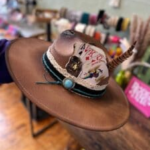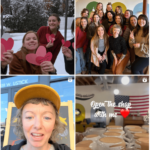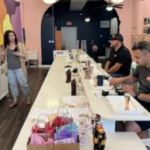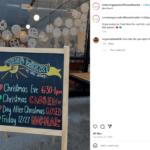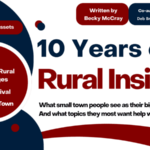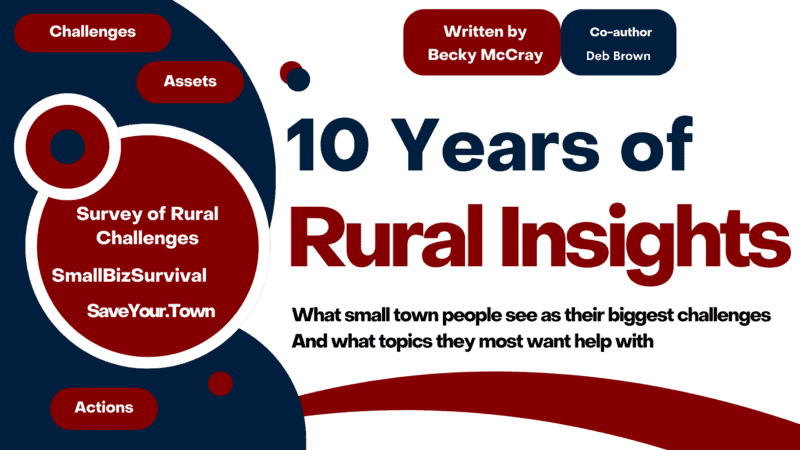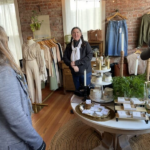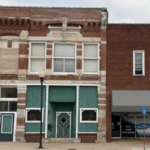Uncategorized
Should I ask competitors before I start a business in a small town?
“I want to start up a new business in town which will compete with an existing one. I believe there are enough customers for both of us. Should I talk to the business owner about my intentions before I start?” That’s the real-world concern from a reader. In small towns, we think about things like […]
“I want to start up a new business in town which will compete with an existing one. I believe there are enough customers for both of us. Should I talk to the business owner about my intentions before I start?”
That’s the real-world concern from a reader. In small towns, we think about things like this. We don’t want to hurt anyone often because we know them, or we know their family.
I’ve never personally asked anyone when starting a potential competitive business or been asked by anyone (except my sister, but that’s a long story). While some people do get angry about it, I believe competition is a good thing, even in a small town. And I say that from personal experience in business.
I discussed this question with my colleague Deb Brown, a former chamber of commerce director and entrepreneur, to get additional ideas.
Generally, we don’t think it’s necessary to speak to them first. It’s also not out of the question, if you feel strongly about it because of the person involved, whether you know them, or the size of the town.
Test your idea first
The main advice Deb and I would offer is to do small tests first to gauge the market. That’s how you’ll know for sure if there is enough demand to support another business.
You can do this for a retail business through pop-ups, renting booths at festivals or events, or through tests selling a few items online or inside another business. For services, you can start offerings online, a mobile location like a trailer, or with a few temporary tests. Once you start those small steps, you’ll learn a lot about what people want to buy, what they’ll pay, and what they are hungry for.
You may find there isn’t demand, so you don’t have to go have that awkward conversation after all.
Look for opportunities to cooperate
Small businesses in small towns have more opportunity to cooperate. Even a direct competitor might cooperate with you. This makes for a much easier conversation than seeming to ask their permission to start. Instead, go to them with ideas for ways to work together.
Here’s an example advertisement from three retail businesses, two of which are direct competitors. All three were along the same block in a downtown.

Three local stores cooperated on this joint ad, marketing their stores together. Photo by Becky McCray.
Ask your small town business questions here
Do you have a question about your small town business or business idea? Reach out on our personal contact form.
From Finance to Creativity: A Journey to Building an Experience-Based Business in Bellefontaine
In today’s fast-paced world, many individuals find themselves stuck in careers that fail to ignite their passions. For some, the journey to rediscovering creativity can lead to unexpected and fulfilling paths. This is the story of one such entrepreneur who transitioned from a corporate finance job to creating a vibrant experience-based business in downtown Bellefontaine. […]
In today’s fast-paced world, many individuals find themselves stuck in careers that fail to ignite their passions. For some, the journey to rediscovering creativity can lead to unexpected and fulfilling paths. This is the story of one such entrepreneur who transitioned from a corporate finance job to creating a vibrant experience-based business in downtown Bellefontaine. Through her journey, Jessica Epley not only embraced her artistic side but also built a community hub that fosters creativity and memorable experiences for all who visit.
Take small steps: craft shows and teaching classes
After college, Jessica ventured into the finance sector, but the reality of staring at Excel spreadsheets for eight hours a day quickly made her realize that this path wasn’t for her. Fortunately, she was in a position to leave that job and take some time to rediscover her passions.
Once Jessica stepped away from the corporate grind, it felt like a fog had lifted. She began to explore her artistic side, diving into painting and macramé. This newfound creativity led her to travel around, setting up at craft shows and markets to showcase her work. Eventually, she transitioned from being a vendor to teaching classes across the state, sharing her love for creativity and crafting with others. She discovered her true passion lies in providing people with memorable experiences that they can cherish forever.

Stepping up to a downtown space
Then a small space became available in downtown Bellefontaine. Tired of the constant setup and teardown of market events, Jessica decided to take a leap and commit to this space for a year, envisioning it as a creative haven. Her goal was to create an environment where people could come, spark their creativity, and walk away with a wonderful memory. Thus, Triple Moon Designs was born.
However, just a few months into this venture, it became clear that the space was too small for the activities she had planned. By March of this year, she made the bold decision to move to a larger location, which allowed her to introduce a new feature: the candle bar.

Adding the candle bar
The candle bar offers a laid-back, low-stress crafting experience for everyone. While it requires significant behind-the-scenes work, it has attracted visitors from out of town who come specifically for this unique experience. As their candles cure, they have the opportunity to explore and enjoy the local shops and restaurants in the community, creating a vibrant atmosphere that benefits everyone involved.


Advice to you
“My advice to anyone offering an experience-based business is to think about how special it can be and shoot for that every single time. I don’t feel like I have a lot of business advice to give yet, but from my limited experience I would remind entrepreneurs that collaboration happens at the top. Being willing and able to work with other local businesses has helped me tremendously in getting my business name out there and given me the opportunity to build a network with other successful people. I’m so thankful for our downtown Bellefontaine business community and how we are working together to make our whole town the unforgettable experience!”

As Jessica continues on this journey, she remains committed to inspiring others and fostering creativity in her community. Her story serves as a reminder that it’s never too late to pursue your passions and create something meaningful.
If you’re interested in learning more about taking small steps to create an experience-based business in your town, don’t hesitate to reach out to us for ideas and advice!
Will trendy axe throwing and escape room businesses last? More experience-based retail: the Hat Bar
Continuing the discussion on experience-based businesses, what happens after everyone in town tries it? Do these businesses go away? Sheila Scarborough posed the question this way: How do all these axe-throwing and escape room places think they’re going to stay in business past a few years? Main Street Expert Jackie Wolven weighed in: In a […]
Continuing the discussion on experience-based businesses, what happens after everyone in town tries it? Do these businesses go away?
Sheila Scarborough posed the question this way:
How do all these axe-throwing and escape room places think they’re going to stay in business past a few years?
Main Street Expert Jackie Wolven weighed in:
In a tourist community they might be ok if they keep it fresh. But like any small biz, if they aren’t making money they will close and move onto something else.
I was also thinking with the current popularity of shows like Game of Thrones, Last Kingdom and Outlander… the axe throwing probably is a cultural phenomenon. And the true crime fandom is just as rabid which might be driving escape rooms.
The Hat Bar: customize your own hat
We’ve talked before about the candle bar in Bellefontaine, Ohio.

Get your own custom western hat in Caldwell, Kansas. Photo via Rustic Longhorn Co facebook page.
In Caldwell, Kansas, there’s a retail business called Rustic Longhorn Co. that features a hat bar. I had to ask what a “hat bar” even was. They sell hats you can customize on site. Pick a cowboy hat or trucker cap. Pick your hat band, patches or other decorations. Assemble your personalized hat right there in the shop.
Won’t people get tired of making hats?
But how many customized hats does this town really need? They do get a lot of western-theme tourism, so it may have staying power.
When everyone in town has enough hats, they can swap it out for a new experience later. The store as a whole remains, even as the experiences change.
Every small town business has to work at keeping their offerings fresh and relevant.

Advertising the hat bar in the window draws in new customers for the Rustic Longhorn Co. in Caldwell, Kansas.
Create customer experiences online like Open the Shop With Me videos, and in person, like Silent Book Club
When Kathleen Minogue of Crowdfund Better mentioned Common Ground Coffee and Market to me, I found their Instagram feed was full of stealable ideas for small business social media marketing. We first talked about how they let customers know about changes to their hours. They’re in Boise, Idaho, which I realize is not a small […]
When Kathleen Minogue of Crowdfund Better mentioned Common Ground Coffee and Market to me, I found their Instagram feed was full of stealable ideas for small business social media marketing.
We first talked about how they let customers know about changes to their hours.
They’re in Boise, Idaho, which I realize is not a small town. I promise I wouldn’t share ideas unless they also worked for small town businesses.
These ideas are perfect for coffee shops, gaming businesses and other third places where people gather and hang out.
Any small town business could copy their “Open the shop with me” video, or their post of staff members as a group.
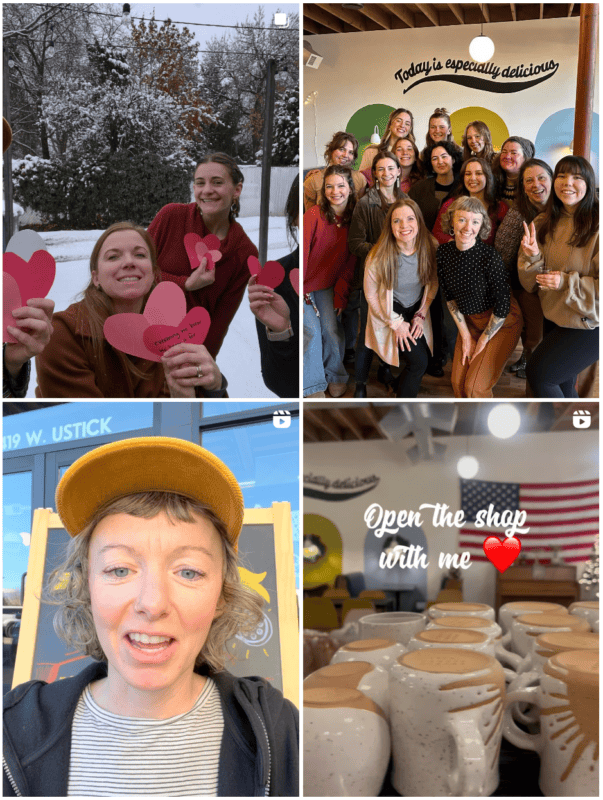
Steal this idea: do an “open the shop with me” video! Image from Common Ground Coffee and Market, Boise, Idaho, Instagram.
Partner with other groups and businesses, even in small ways.
You don’t have to come up with, organize and then staff every event. Start looking for other clubs, groups, people and other businesses you can partner with. What do people like to do in your town, for fun or activities? Try tapping into those folks to help create experiences inside your business.
Notice how each of these events is in partnership with another local group or business. Image from Common Ground Coffee and Market, Boise, Idaho, Instagram.
Another idea to steal: SILENT book club.
I’d love to join someone’s silent book club! And how easy would it be to make one?
In another photo, the Common Ground folks showed a pile of books on the table to kick things off. Just bring some of your own used or To Be Read pile from home, grab some used books from the library sale, or just ask around!
No rules. Just read.
Need more coffee shop and gathering place ideas?
Check out these past idea-fests:
Hands-on and experience-based businesses boost local economies
Guest post by Jason Duff, founder of Small Nation Ever wanted to pour your own candle? Now you can right here in Downtown Bellefontaine! Triple Moon Designs in Bellefontaine, Ohio, recently added a new and exciting candle bar, offering a unique experience not typically seen in small towns. My team has had the chance to try it out […]
Guest post by Jason Duff, founder of Small Nation
Ever wanted to pour your own candle? Now you can right here in Downtown Bellefontaine! Triple Moon Designs in Bellefontaine, Ohio, recently added a new and exciting candle bar, offering a unique experience not typically seen in small towns. My team has had the chance to try it out and they’re raving about it. Owner Jessica Epley has curated the best-smelling and cleanest scents, as well as some of the nicest vessels that range from only $20-$35.
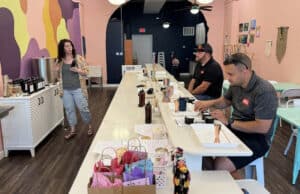
Candle making as a business gets a new spin in this “candle bar” where customers can design and make their own candles. Triple Moon Designs in Bellefontaine, Ohio. Photo courtesy of Small Nation.
Plus, if you like your created scent, Jessica can re-create it for you to make for the perfect Christmas or new client gift!
How Candle Making Creates an Economic Ripple Effect
Jessica’s new candle bar is a perfect example of the kind of destination-type experience that brings vitality and vibrancy to our community. Creating these unique experiences in a small town setting holds immense value. They draw both locals and visitors. The candle bar isn’t just about making candles; it’s about the experience of creativity and personalization. Visitors have the opportunity to craft something uniquely their own, and this hands-on activity creates a memorable and engaging experience that keeps people coming back.
One notable aspect is the two-hour curing time for the candles. This built-in waiting period is a strategic advantage for our downtown area. While their candles cure, visitors are encouraged to explore and enjoy the other offerings in Bellefontaine. They can dine at one of our local restaurants, browse the many boutiques, or enjoy a coffee at a nearby café. This not only enhances their overall experience but also supports other local businesses, creating a ripple effect of economic benefit.
By people like Jessica integrating destination-type experiences like the candle bar into our downtown, it’s creating a vibrant, interconnected community where businesses support each other. This synergy is vital for the sustained growth and development of small towns. It transforms our downtown into a lively hub of activity and engagement, attracting more visitors and encouraging local residents to explore and invest in their own community.
About the guest author
Jason Duff is the Founder of Small Nation. He leads the Small Nation team in developing places, spaces and dreams for small towns and small town entrepreneurs across the country. The 4th generation of a family of entrepreneurs, he started his own businesses before leading a team that has completely revitalized the city of Bellefontaine, Ohio, population 14,000. Read more about how Jason and team did it at Small Nation.
How to let customers know when changing your business hours
Post extensively on social channels, and pin your hours post to the top of your page Your small business has times when you need to change your hours either for holidays, staff issues or (my favorite) extending into evening hours. How do you retrain your customers so they notice the change? Let’s look at a […]
Post extensively on social channels, and pin your hours post to the top of your page
Your small business has times when you need to change your hours either for holidays, staff issues or (my favorite) extending into evening hours. How do you retrain your customers so they notice the change?
Let’s look at a real-world example from our friend in Boise, Idaho, (I know, kind of a big town) Kathleen Minogue.
“My local coffee shop just extended their Monday hours, and I will get heading there this afternoon,” Kathleen said. “They did a whole video about it on the socials to tell us and have pinned their hours to the top of their page.”

Post your temporary hours on your favored social channels, and pin them for as long as they are current. Image from Common Ground Coffee and Market, Boise, Idaho, Instagram.
If your website is hard to update
If your website is not easy to change, use it to let people know what social channel is your main tool for quick updates.
Post your most usual hours on your hard-to-change site, then say, “For current hours, follow us on…” and then give the social link.
Kathleen said her colleague Scott Madsen was the one who suggested pinning the posts for visibility.
“It’s a quick and responsive way that keeps their customers in the know and can be pinned so easily for all followers to see when they visit their profile,” Scott said.
Crowdfunding? Crowdfund Better
Kathleen and Scott are part of the team at Crowdfund Better. I recommend them to everyone who tells me they are considering crowdfunding for their small business.
Survey of Rural Challenges 2015 – 2025 results
Download the PDF report Executive Summary The Survey of Rural Challenges asks rural people to share their ground-level insight into the challenges they face and the assets they can use. This report analyzes over 2200 responses from communities across the US and Canada from 2015 to 2024. The responses show what’s changing and what isn’t […]
Download the PDF report
Executive Summary
The Survey of Rural Challenges asks rural people to share their ground-level insight into the challenges they face and the assets they can use. This report analyzes over 2200 responses from communities across the US and Canada from 2015 to 2024. The responses show what’s changing and what isn’t in small towns and rural places from the point of view of their own people.
- Persistent challenges: Youth out-migration, downtown decline, workforce shortages and struggles with local business marketing continue to challenge rural communities.
- Fast-moving concerns: The housing crisis, lack of adequate childcare and lack of support for small businesses have increased as significant rural challenges in recent years.
- Slow-building challenges: Over time, the lack of volunteers, the pressure from online competition on local businesses, and the lack of usable commercial buildings have risen to greater importance.
- Appreciating assets: The strength of rural communities to address their challenges comes from significant assets, including natural resources, strong social bonds, a spirit of entrepreneurship, a small but dedicated workforce and action on broadband access.
- Demographic shifts: Besides basic population numbers in their communities, rural people noted differences in ages, professions, education and more.
- The external view: Much of this nuance is lost in the external understanding of rural challenges and assets in the media, government, organizations and agencies.
The primary conclusion is that although good ideas are stifled by conflict, negativity and old way thinking, communities that are open to new ideas can thrive. Agencies, organizations, media and policy makers can use these insights to improve how they serve rural people.
Survey of Rural Challenges Ten-year Trends
The Survey of Rural Challenges collected input online from rural and small town people. The questions offered multiple-choice options for challenges and open-ended responses about assets, community makeup and anything else they wanted to share about their communities and businesses. The survey was opened for limited time periods, with results shared in 2015, 2017, 2019, 2021, 2023 and 2024. This data over time provides a view of the changes in rural communities.
Authors Becky McCray and Deb Brown analyzed the complete set of over 2200 responses, identifying challenges that have persisted, new fast-moving concerns and some slow building challenges that have risen over time. They also identified rural assets, the internal view of demographic shifts in rural communities, and insight into how the external view differs.
The primary insight: Good ideas are stifled by conflict, negativity and old way thinking, and towns that are open to new ideas can thrive.
In all rounds of the survey, open-ended responses were dominated by all kinds of negativity, the stifling influence of the old guard in leadership, and people who tried to slow down any changes. Responses mentioned leaders not moving forward, not acting on suggestions or new ideas, people with a “poor us” attitude, and communities breaking into factions for and against change. Personal agendas, local organizations that don’t work together and infighting hold communities back.
In 2019, one response said:
The old guard had a lot of experience – good & bad – and with new ideas tended to say “we tried something like that once…” and instead of taking what didn’t work & learning from it, crossed it off the list of things to try at all
Facing apathy, resistance to new ideas and focusing too much on the past all inhibit how willing people say they are to keep taking action. People’s initiative becomes “a strength hobbled by a problem,” one response from 2023 said.
Iowa State University’s Small Town Project showed that openness to new ideas was the factor most correlated to positive outcomes and thriving communities.
If there is one single thing that can most positively change the trajectory of rural communities, it is to be more open to new ideas.
Applying the Idea Friendly Method from SaveYour.Town is one way to accomplish this.
Persistent challenges: Youth out-migration, downtown decline, workforce shortages and struggles with local business marketing continue to challenge rural communities.
Each of the following challenges has remained at or near the top of the multiple choice challenges across all rounds of the survey. In 2021, challenges stemming from the pandemic and economic crisis ranked lower than these persistent challenges. Any rural support that does not consider these top challenges is ignoring critical ongoing needs.
The loss of young people has consistently been one of the top five challenges. Residents see the annual exodus of high school graduates as representing the loss of their town’s future. Rural residents are not only concerned with retaining young people but also attracting new younger adult residents.
The decline of downtown areas is another highly visible symbol of changes in rural communities. Shifts in economic realities have changed what businesses are present and the amount of activity in downtowns over most people’s lifetimes. Though more open-ended comments have shown appreciation for their downtown areas’ businesses, buildings and charm, “dead” downtowns continue to rank as a top multiple choice challenge. The lack of investment in downtown infrastructure is also a factor in the need for usable commercial buildings, one of the slow-building challenges.
Small town businesses continue to struggle with effective marketing. Traditional media has declined in rural areas, removing a once-powerful tool for local business marketing. Local business people say the fast moving changes in online marketing have been difficult for them to keep up with and consistently master.
While workforce challenges are not unique to small towns, rural businesses face the added complication of a smaller labor market to begin with. Employees are often cited as a great asset of rural businesses, even as organizations struggle to hire new people. One person said in 2023, “The biggest challenge is keeping your greatest assets going. I work in health care, and we currently have great staff. However, there are many open positions that cannot be filled.”
Fast-moving concerns: The housing crisis, lack of adequate childcare, and lack of support for small businesses have rapidly increased as significant rural challenges in recent years.
These fast-moving challenges may surprise some observers and some rural residents. The data challenges existing views of small towns formed over decades and calls for quick responses from rural-serving organizations, policy makers and local leaders.
Rural housing has moved from a key asset to a critical shortage. In 2015 and 2017, housing was barely mentioned in responses. Cheap housing was seen as a small town asset, drawing new residents out of more expensive urban areas. Starting in 2019, housing ranked as a top rural challenge, and it has remained in the top three since then. The increasing cost of housing, declining condition of existing houses, loss of houses through attrition and a lack of new construction were all mentioned.
The lack of childcare has quickly risen to crisis proportions, made more evident during the pandemic and post-pandemic. Without adequate childcare, responses said people are kept out of the rural workforce and potential new residents are reluctant or unable to move into small communities. Although several people mentioned new housing initiatives in their communities, progress on child care remained elusive.
The lack of support for small businesses shot to the top of the rankings on the most recent survey. Feelings of not being supported have long been mentioned in responses, but this marked a sudden spike in concern. Business owners talked about unfair incentives offered to recruit outside businesses, as well as the lack of direct support from officials and organizations.
One person said in 2024, “Chamber of Commerce only cares about the big money businesses/industry and is stuck in the 70’s 80’s way of doing business.”
Slow-building challenges: Over time, the lack of volunteers, the pressure from online competition on local businesses, and the lack of usable commercial buildings have risen to greater importance.
Even experienced rural observers may have missed these challenges as they have slowly risen to the top. Current rural programs have not proven effective at stopping this increase.
The lack of usable commercial buildings frequently surprises outside observers. In 2015 the lack of usable buildings ranked in the middle of the business challenges, ranking about the same as the challenge of finding a small business loan. Since then, the lack of usable buildings has climbed into the top challenges, while the difficulty finding a loan has continued to drop in the rankings.
The lack of buildings is closely tied to the decline of rural downtowns and the lack of investment in small town infrastructure. It is complicated by individuals who buy buildings, sometimes many buildings in a single community, but do not maintain them or make them available for commercial use. Many are used as cheap storage, either for the remains of a former business or personal items.
“We have a lot of dilapidated buildings in our downtown, many of which are owned by 2 families who are pack rats and have them filled with junk and garbage,” one 2015 response said. “They never plan to open these as business and it makes our town look terrible.”
Volunteers are seen as strong assets in rural communities, and the lack of volunteers is a growing challenge. Since 2021, lack of volunteers has ranked in the top five challenges, after ranking in the middle on earlier surveys. Responses frequently mentioned the same few volunteers burning out, making it harder to maintain events and organizations.
Existing volunteers are often described as seniors, retired and “tried and true” people. Younger people are often mentioned as unwilling or uninterested in volunteering. Younger people who try to volunteer say they are ignored, run into inflexible ways of doing things and are assigned “life sentence” volunteer terms.
Competition from online sales increasingly squeezes local businesses in small towns. Early responses in 2015 and 2017 mentioned big box stores as the key competition. That has shifted to increasing mentions of online competition. This reflects the US Census Bureau reports of e-commerce sales of 7% of total retail sales in 2015, increasing to 16% in 2024.
“Shopping habits of people have changed, so it’s difficult to get people to come downtown when they can easily shop online,” one response from 2024 said. “I don’t see that reversing any time soon.”
Appreciating assets: The strength of rural communities to address their challenges comes from significant assets including natural resources, strong social bonds, a spirit of entrepreneurship, a small but dedicated workforce and action on broadband access.
Rather than focus only–or even primarily–on challenges, rural communities benefit from focusing on their wide variety of assets. Services and policies can also be more tailored to rural assets.
When asked to name their assets, rural people most often point to their natural resources. Easy access to recreation in nature remains a strong draw for rural residents. Survey responses often mention scenic beauty and an appreciation for the unique natural qualities of their area. They also mentioned natural resources as an economic asset, including farming, minerals and mining.
While much has been written about the strong social bonds of rural areas and small towns, it remains a complex topic. Small towns often have stronger ties between groups who are similar and weaker ties across groups who are different. People mentioned trouble breaking through cliques or small groups, especially those who wield decision-making power.
One way that the social bonds play a positive role is through people’s sense of connection to the community itself. The sense of connection leads them to focus on solving their own problems and addressing their own challenges.
One person in 2024 said, “Best assets are nature: the mountains, the trails, outdoor activities. Also welcoming atmosphere, community activities, good elementary school.”
Rural entrepreneurs said they value their relationships with customers and their communities. They often cite their workforce as one of their greatest assets, and they express a challenge in finding enough workers to meet their needs.
Broadband is shifting from a challenge to an asset. In the early surveys in 2015, through 2019, most mentions of broadband focused on the lack of access. From 2023 and 2024, broadband and fiber access were more often mentioned as assets or that action was being taken to improve it. Only a few mentions of a lack of broadband were made since 2021. There is also a need for supporting broadband adoption and development.
One 2019 response said, “we have fiber optics broadband but no industry around it – we need shared space and knowledge about marketing our rural community to remote workers and small tech companies.”
Many other assets were mentioned, showing the variety of rural communities today across the US and Canada.
Demographic shifts: Besides basic population numbers in their communities, rural people noted differences in ages, professions, education and more.
Demographic trends will continue to alter the makeup of rural communities. Outside observers may miss rural people’s nuanced views of differences within individual communities.
Rural people have a broader view of differences than might be expected, mentioning a wide variety of personal characteristics. The most common differences mentioned were related to race/ethnicity, youth/aging populations, education/skills, business/professions, and cultures/ideas. Gender spectrum and LGBTQIA were also mentioned, as well as income/class, disability, family structure, religion, political views, and military service.
More people described their communities as diverse than not on this survey. Many more people mentioned increasing diversity than mentioned conflict between demographic groups. The most common struggle mentioned was being welcoming to diverse populations.
The external view: Much of this nuance is lost in the external understanding of rural challenges and assets in the media, government, organizations and agencies.
These disconnects can lead to mis-matched services being offered, missing the real challenges, or over generalizing people, businesses and communities. Overwhelmingly negative stories influence rural self perception.
Crime and drug abuse continue to dominate narratives in external portrayals of rural areas. Rural people consistently rank these at or near the bottom on this survey.
Reporters are commonly dispatched to small communities struck by natural disasters or major economic losses because these are considered newsworthy events. The resulting coverage overrepresents these crises. On the survey results, crises or shocks to the community are seldom mentioned. In the 2021 pandemic-period survey, challenges stemming from the pandemic and economic crisis ranked as less common challenges than the persistent rural challenges.
Rather than passively waiting for outside businesses or organizations to come to their rescue, rural people report taking action. Even when asked for their challenges, they often start talking about trying solutions.
The stereotype of rural areas lacking culture ignores what rural people on this survey see as a major asset: their events and activities, their arts and artisans, their foods and traditions. Many times, rural communities are depicted as all white, which does not match many real-world communities or rural people’s own views.
Despite the stereotype of small town businesses as outdated or slow, the survey results show they are innovative, open to new ideas and focused on their customers’ experiences.
Although rural economic development often centers around jobs, it was one of the least-mentioned challenges in this survey. Good jobs are mentioned at least as often as a lack of jobs. While recruiting outside businesses is a pillar of traditional development, very few responses mention it. Instead, people talked about growing their own small businesses.
Rural small business owners show little interest in business plan assistance or pitch competitions, yet they remain popular types of assistance offered to rural businesses. On this survey, finding a usable commercial building was a more common challenge than finding a business loan. More small business lending funds are announced every year, yet little is announced to increase the supply of usable commercial buildings in small towns.
Action steps
Based on these insights into rural communities and small towns, practical steps to take can also be outlined. These action steps come directly from the challenges and assets identified by rural communities themselves.
Tailor support to specific community concerns and assets. Use this report and the biennial Survey of Rural Challenges results as they become available. Listen to the people in the community before making key decisions.
For business support, pay more attention to marketing and workforce. Provide more small opportunities for testing business ideas with little investment. Put at least as much or more emphasis on increasing usable buildings than increasing business lending.
Funnel financial resources to improve housing, childcare, downtowns and commercial buildings. Consider classifying these to qualify for economic development funding or moving funding from lower-valued services such as business plan assistance, pitch competitions or small business lending funds.
Broaden rural media coverage beyond poverty and disasters. Partner with and amplify stories from small town media outlets. Use the challenges and assets in this survey as a jumping off point to collect fresh local news.
For rural residents and small town leaders, be more open to new ideas and adopt the Idea Friendly Method to spur local innovations.
Participants’ own words
These quotes come directly from open-ended responses to the survey. Emphasis has been added, and some have been edited for length and clarity. Minor grammatical errors and idiosyncrasies were left in place.
Apathy and Old Way Thinking
- “Apathy is hard to overcome! There has to be a way and I’d love to hear how changes can be made to encourage pride in a small city with no extra funds.” (2024)
- “I’d love to hear about how other small towns have helped their community leaders get over the fear of failure. It has certainly hindered growth and development in our community. How do we best encourage people to take more risks? Be more creative with spaces?” (2015)
Small Business Needs
- “Small businesses need financial resources and business advisors. Most things are only available to those who run a non-profit.” (2024)
- “What isn’t working are the traditional approaches to economic development, rather than a strategy that focuses on ‘growing our own’ and entrepreneurship and small business development.” (2021)
- “[Online marketing] changes so fast & there’s so much technical jargon for SEO/ websites/mobile that I end up feeling stupid and end up ignoring it all. (2015)
Housing
- “I think we would have more young people live here if there were housing available.” (2021)
- “City officials keep shooting down low & medium income housing & new apartment buildings.“ (2015)
Welcoming
- “I wish members of the community would be more inclusive of residents who wish to participate in improvements, committees, and working toward more positive change in our community. Sometimes it feels like high school.” (2024)
- “There’s been a historical lack of diversity and little respect for people who don’t fit the norm. But I have hope that with increasing numbers of younger folks and more general awareness of the importance of diversity and equity that we’ll turn the corner.” (2021)
Using Assets
- “Covid helped the county take a better look in the mirror and realize status quo isn’t working anymore. …The quarterly meetings with our schools and businesses has been communicatively amazing in taking our county up several notches in employee training … entrepreneurship development, career center and community college involvement and basically training our students to think local first in employment and purchasing. Wins all around. The progress has led to some local and county elected official changes to younger forward thinking members. Still work to be done but the tide has turned to rising here raising us all.” (2024)
- “…We are in the process of revamping our Chamber of Commerce and moving to a more Regional model. We are also starting to look at things like development through arts & culture” (2019)
- “….we’re an abundant community… food, skills, culture wise etc …How do we access that abundance” (2015)
Success with Challenges
- “In a community survey from 2020-21, Affordable housing, access and affordability to child care, and expanding Broadband were three of the top issues residents identified. The County and region has been making meaningful progress toward housing and Broadband, but childcare remains elusive..” (2024)
- “I do think we are lucky to have people who care and are willing to work together to achieve great things. We just maybe haven’t been able to find ways to promote what we have here. It might be that we are unsure of exactly what our assets are.” (2019)
Optimistic Future
- “Just that we are trying to rebuild after Covid and are taking small steps to working towards our new goals..” (2024)
- “A group of progressive minded “young” (30 to 55) leaders have joined together to celebrate what is right about our community and to make some fun things happen.” (2019)
- “We’re at a crossroads here with the challenges to the Old Way by many new people moving in to be a part of an industry the Old Guard doesn’t understand. However, there are some bright spots on Main Street, and we are optimistic about the future. :).” (2024)
Methodology
This report was written by Becky McCray and Deb Brown, the co-founders of SaveYour.Town. It is based on analysis of all six rounds of the Survey of Rural Challenges conducted between 2015 and 2024. The survey data provides insights into the evolving challenges, assets, and perceptions of people in rural communities and small town businesses. Reports of survey results including the complete text of each round of survey questions are available at https://saveyour.town/survey-of-rural-challenges-news/
The survey is a project of SaveYour.Town and SmallBizSurvival.com, and it is typically open for responses every other year. Participants came primarily from the US and Canada, with a few from other countries including Australia, the UK, and New Zealand. Between 2015 and 2024, over 2200 responses to the survey have been received.
Responses were collected online from subscribers and visitors to SaveYour.Town and SmallBizSurvival.com, from media coverage and cooperating groups that publicized the survey. Respondents identified themselves as rural by completing the survey, and a portion identified themselves as business owners by responding to the business question.
Based on survey responses and SaveYour.Town’s customer data, most respondents serve as community leaders and officials, work in community and economic development, own a business, work in a community-oriented business, or volunteer informally in their community.
About the authors and organizations
About SaveYour.Town
SaveYour.Town believes small towns can be saved by their own people using their existing assets. Deb Brown and Becky McCray joined forces in May 2015 to help small towns and rural communities thrive. They specialize in low or no cost solutions, ones that will work in even the tiniest of towns. Becky and Deb deliver presentations internationally, lead site visits and community brainstorming sessions, and create online videos and short courses of practical steps that can be put into action right away. They are frequently featured as rural experts on podcasts and in media interviews.
About Small Biz Survival
SmallBizSurvival.com publishes practical articles for rural small businesses. It was founded in January 2006 by Becky McCray from Oklahoma and has published over 3,000 posts by a dozen expert authors. Over the years, it has achieved top ranking among small business blogs. For her work as publisher, McCray has been named one of the Power Players in Technology Business Media and a Small Business Influencer Journalist four times.
About Becky McCray
Becky McCray is a lifelong rural entrepreneur, cattle rancher and co-founder of SaveYour.Town. She created the Survey of Rural Challenges in 2015. As an expert on rural communities, she often collaborates on rural publications, initiatives, advisory boards, listening sessions and advocacy events including Oklahoma State University’s Rural Renewal Initiative, American Independent Business Alliance campaigns, and the Harvard Kennedy School’s Reimagining the Economy Project.
In 2013, Becky and Chicago author Barry Moltz wrote the award-winning book Small Town Rules, published by Que BizTech. She has presented at more than 300 rural and small town events in the US, Canada, UK and Australia, including Main Street America, International Economic Development Council (IEDC) and TEDx. She makes her home in Hopeton, Oklahoma, a community of 30 people.
About Deb Brown
Deb Brown is a dynamic small-town advocate and community development expert with a wealth of experience helping rural communities. As the co-founder of SaveYour.Town, she has been working alongside Becky McCray for a decade, providing practical advice and innovative solutions to shape brighter futures for small towns.
Deb excels at building connections, storytelling, and active listening. Drawing on skills she developed through chamber of commerce work, a variety of business and management experience, and her love of small towns, she guides people in taking small steps toward their ideas and helps them find the resources and connections needed to bring those ideas to fruition. Deb has helped communities address challenges like empty buildings, loss of residents, downtown rejuvenation, creating economic growth, and marketing and promotion.
Deb developed stories from the rural communities she has worked with and wrote a book, “From Possibilities to Reality: Save Your Small Town with these Uniquely Do-able Ideas, Projects, and Success Stories.” It is a comprehensive workbook filled with practical strategies and real-world examples for small-town revitalization.
Download the PDF report
Survey Results and News Room:
For more info contact
- Becky McCray becky@smallbizsurvival.com
- Deb Brown deb@saveyour.town
Keywords and classification:
- Survey of Rural Challenges
- Rural surveys and polls
- What rural people need and want
- What a small town needs
- Rural people needs and wants
- Rural challenges
- Small town issues
- Urban-rural divide
- Rural policy
- Diversity in rural communities
- Diverse small towns
- Rural assistance programs
TREND 2025: Retail’s Big Split: what small town retailers can do now
Remember the Retail Apocalypse around 2017? In a media interview this week, I brought up that it was actually Retail’s Big Split, not an apocalypse, and it’s ongoing. The reporter asked me to explain, so here’s my update for today’s retail landscape. “Everything gigantic in American life is about to get smaller or die.” […]
Remember the Retail Apocalypse around 2017? In a media interview this week, I brought up that it was actually Retail’s Big Split, not an apocalypse, and it’s ongoing. The reporter asked me to explain, so here’s my update for today’s retail landscape.
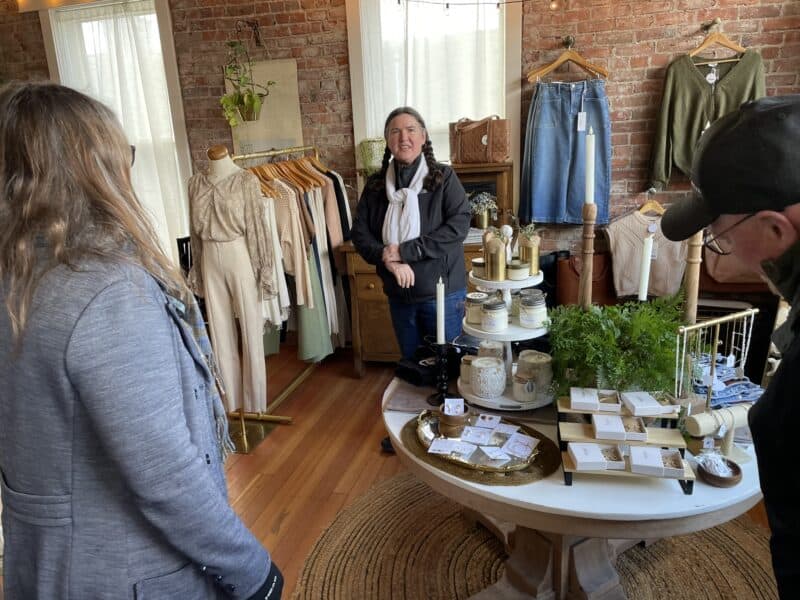
This combination business offers tiny spaces to retail pop-ups along with coffee and sweet treats. It offers plenty of meaningful, interesting purchases in this historic building in Potlatch, Idaho. Photo by Ana Blaisdell.
“Everything gigantic in American life is about to get smaller or die.” James Kunstler wrote in 2013. He said big box retailers were on the brink of scale implosion, and that “every element of economic reality is now poised to squash them.” It was a provocative stance for 2013, and I’ve been monitoring small retail trends at least as long.
By 2017, it seemed like we went over the brink. Every week brought another story of big retail jobs lost, the shuttering of stores, and the financial losses at big retailers.
You might think small retailers, especially small town retailers, don’t stand a chance. But that’s not true.
There are a lot of news stories that point to eCommerce as the cause of big in-person retail’s decline and also as its replacement. Today, you don’t run to the big box store for regular items like paper towels or laundry soap. You just tell your voice assistant to order it online. Even more automated, you’ve probably set up all kinds of regular items on recurring shipments that you don’t even think about. Smart refrigerators can already integrate with your voice assistant to make it easy for you to place more orders. Soon the fridge itself will notice you’re low on something and just reorder it for you. That means no chance for a big box store to capture an impulse purchase when you make a quick run to the store for those items.
It’s worth noting that online sales today only amount to 16% of all retail sales, though that has doubled since I first wrote about the Big Split in 2017. Online sales aren’t the only cause for big retail’s decline or the only replacement. We’re also purchasing less for a variety of societal and cultural reasons. See also the Buy Nothing group you belong to on Facebook, underconsumption core, and thriving interest in sustainability, secondhand and vintage shops. But that still leaves a lot of purchases being made, just not as much at big boxes and not all online.

Small town retail still brings meaning and charm to everyday purchases, like this store in Rosthern, Saskatchewan. Photo by Becky McCray.
Where are the rest of sales going? Small retailers.
While all boring retail purchases get automated, interesting retail purchases become small, sustainable, curated, handcrafted, local and integrated with technology. Items we care about, are interested in, and want to enjoy shopping for, will come from small local retailers.
Author David Sedaris summed up this consumer feeling in an interview:
“I’d rather go to an actual shop — preferably a small one — than to a harshly lit superstore, or, worse still, a website,” Sedaris said. “I don’t want to buy my books and my toilet paper and my clothing all under the same roof. I want beauty in my life. I want charm. I want contact with actual people. It is, for me, a large part of what makes life worth living.”
The MasterCard SpendingPulse for Small Business reported on the “general consumer trend to shop small” for years. IBM Research predicted local retailers’ increasing use of technology.
Smart local stores today do both digital and physical retail. The physical store is close to customers for immediate gratification. Local business owners tell us on the Survey of Rural Challenges that they add the product information and reviews of online, plus the data to be more personalized, like wishlists and recommendations. Local stores bring the product right to where the shopper can physically touch it.
Classes and hands-on activities turn shopping into a memorable experience. That’s a layer of meaning that no big box store or online order can duplicate.

The experience of visiting a converted barn, shopping dozens of local artisans, and even joining a hands-on class brings more meaning to every purchase from the Artists at the Dahmen Barn in Uniontown, Washington. Photo by Becky McCray
What can local stores in small towns do today to capitalize on retail’s big split?
-
Use big retail’s own tools against them. Try these 7 big-retail tricks including automatic orders, delivery, and better recommendations.
-
Add more technology to be more human. Use tablets to improve your service. Teach customers how to buy from you through Alexa and Siri.
-
Offer experiences and items that can’t be bought online. Locally-produced items, personalization and special services give you an advantage. In store classes, demonstrations and hands-on crafts are memorable experiences.
-
Be your best small town self. Use your 7 Strengths as a small town retailer and shore up these 7 Common Weaknesses of Local Shops.
You don’t have 52 weeks this year
By Rob Hatch Thirty-six weeks. Part of my process for planning my business for the New Year is to do a little reality check on exactly how much time I have to work with. What are you talking about, Rob? You have a year. Technically, that’s true. However, on closer inspection, I only have 36 […]
By Rob Hatch

Thirty-six weeks.
Part of my process for planning my business for the New Year is to do a little reality check on exactly how much time I have to work with.
What are you talking about, Rob? You have a year.
Technically, that’s true. However, on closer inspection, I only have 36 FULL weeks available.
36 is the new 52
My process is pretty simple. I set up a spreadsheet listing every week in 2025. Right off the bat, you’ll notice that the first whole week begins on January 6th.
Next, I block off the weeks when I know I will be on vacation and spending time with friends and family.
Then, I note each week a holiday or personal event occurs that will limit the time I have available for work.
I noted weeks when my children are on school break, and I want a lighter work schedule.
I look at the seasonal ebbs and flows of our family life, such as when we begin and end the school year.
Taking all that into account, I was left with 36 full weeks.
Thirty-six weeks is a very different number to work with than fifty-two.
Here’s what I found most helpful about this exercise.
1. I am starting my annual planning by prioritizing time with my family. I am deciding ahead of time to set aside significant time for that.
2. Many of the other weeks (holidays, school vacation, weeks of transition) will happen regardless. By planning for them, I can plan around them.
3. As I look at what I want to accomplish next year, I have a clear picture of the time resources available to commit to achieving them.
Thirty-six full weeks.
Your number will likely be different. The point is to figure out your number and plan accordingly.
Boost your co-working space with social hours
When I visited Caldwell, Kansas, the manager of the co-working site said they had filled their private offices, but struggled to attract day users. People who work from home like working from home. They don’t want a full time office, so they said they don’t want to use the coworking space. How can the coworking […]
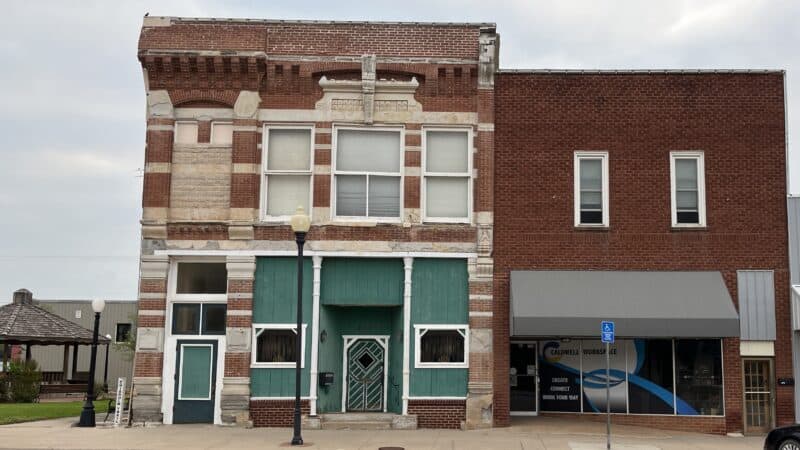
The Caldwell Workspace is on the right. Photo by Becky McCray.
When I visited Caldwell, Kansas, the manager of the co-working site said they had filled their private offices, but struggled to attract day users.
People who work from home like working from home. They don’t want a full time office, so they said they don’t want to use the coworking space.
How can the coworking space attract those work-from-home folks?
Promote the “co” part more than the “working” part.
At their best, co-working spaces are human spaces, Emergent Research has been saying for ten years now. Studies found that people who use co-working say it makes them less lonely. That’s the part to talk about, much more than the fact that you can work there.
Start by providing your work-from-home people with social hours and temporary events so they can connect and build community with each other. That will help their wellbeing right away. Plus, as long as they’re in the space, they’ll look around and found out more about the space and the services it offers.
Social hours also give you (the manager of the space) a chance to ask more about what they do, what they want and need. Do they want day time hangout events? Are they eager to be social? Do they really just need a copier? I don’t know, but they’ll tell you when you get them together to Build Connections. (That’s Idea Friendly, of course.)
Bonus: you can bring in business supporters like the chamber of commerce or advisors like the Small Business Development Center. When they meet each other in an informal setting, they may be more likely to connect.
Schedule a social hour, and set a goal of three people attending. Even three people is enough to start building community. Put the word out all the ways you know how: local Facebook groups, the chamber of commerce email newsletter, signs around town, and text some friends. Take a lot of pictures so you can use them to promote the next one.
Then try another one, maybe at a different time or a different day. Experiment. Take Small Steps. (That’s Idea Friendly, too.) Let me know how it goes.
Learn more
Find more practical steps you can take in SaveYour.Town’s video Remote Work Ready: Zoom Towns. Everything you’ll learn is do-able, affordable and scaled for small towns.



